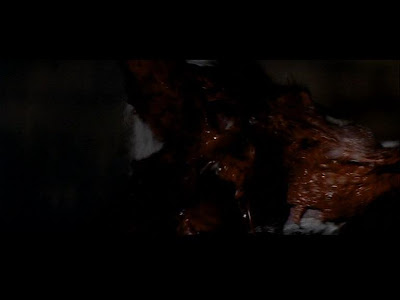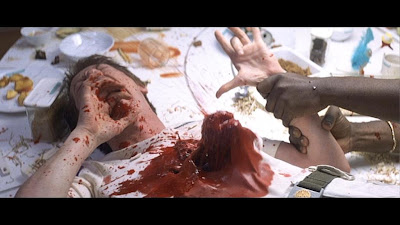
I love the idea that I once read on a science fiction story published in Analog some years ago: the couple having a fight because the wife complains that the husband snores, a fact he adamantly denies. They decide to buy a sound-activated tape recorder to set things straight. When they play back the tape, they hear someone speaking in their room… speaking about them, while they lay asleep, defenceless. That is a spine tingling thought. The fact that I do not remember the title of that story or the name of its author is due, mainly, to the fact that it didn’t live up to expectations. Something I suspect is usually true of almost all urban legends. They’re great as a premise, but once you start to explore, to rationalize, they’re bound to lead you to ludicrous conclusions.

And I believe that is the main failure of Álex de la Iglesia’s LA HABITACIÓN DEL NIÑO (THE BABY’S ROOM in the American edition), the first film on the PELÍCULAS PARA NO DORMIR (FILMS TO KEEP YOU AWAKE) revival of Narciso Ibañez Serrador’s HISTORIAS PARA NO DORMIR television series (3 seasons, 1966, 1967, 1982). Packing an immense load of references and themes, from the haunted house concept to the doppelganger conundrum of finding out who is who, along with quotes from endless other films and TV series (from HAMMER’S HOUSE OF HORROR and PROFONDO ROSSO to THE AMYTIVILLE HORROR and THE SHINNING), LA HABITACIÓN DEL NIÑO keeps your mind busy enough to overlook it’s core senselessness, but not to entirely erase it.


Juan and Sonia (Javier Gutiérrez and gorgeous Leonor Watling) move with their new-born baby into a house they’re restoring and that they were able to buy below market prices for that upscale neighbourhood. When they get a baby sound monitor from Juan’s sister, they hear the voice of someone speaking to their child in the baby’s room. That is the first step that will lead them down the marriage entropy road, a road well travelled by the likes of Jack Torrance and other countless obsessed parents. When a quick search of the house proves there is no one there, they buy a video monitor where sure and soon enough, Juan sees a sinister man sitting by the baby’s cradle. Fear soon brings out the worst in him, allowing de la Iglesia to rub some dirt on feelings of racial prejudice deeply buried in European countries like Spain, France or Portugal, as well as highlighting the ever present fear of old age and physical senescence (“Somos viejos, y los viejos estamos todos locos”). When his fear and family protection instincts almost lead to him accidentally killing Sonia, she decides to leave with the baby, allowing Juan to dive unchecked into despair.



The second act of the film relies heavily on Javier Gutiérrez’s capacity to convey the often portrayed on screen descent into semi-lunacy as things start to spiral out of control, and in this he succeeds fairly well, although he’s clearly no Jack Nicholson. Unfortunately, de la Iglésia’s resort to that old cliché of the “supernatural expert” that will explain things to the troubled protagonist – in this case a journalist armed with quantum physics theories – clumsily deflates the meaning of Juan’s ordeal and practically destroys the film’s cohesion. I do believe that the supernatural horror in films works best when it is kept at the symbolical level, at the level of the primal fear, of the uncanny and unexplainable things in the darkest recesses of one’s mind. That’s what has made such timeless classics as THE HAUNTING (1963), THE BIRDS (1963) or THE SHINNING (1980) worth viewing once and again. Once you rationalize the horror element, you subject it to enquiry, and enquiry demands total coherence for it to work; that’s what made such beautiful failures as PRINCE OF DARKNESS (1987) what they are: failures.






And that is what drags LA HABITACIÓN DEL NIÑO a couple of steps down in the ladder that climbs to excellence. (A word to the wise, now: if you haven’t seen the film yet, maybe you should skip these next sentences). Bed ridden and expert in the kind of UFO lore that is paramount in Spanish tv infotainment today, Sancho Grazia’s Domingo tell Juan about the famous Schrödinger’ cat paradox, using it as an analogue to what happens between parallel realities, which you sometimes can glimpse through electronic apparatus whenever some strong emotional event imprints itself into matter – a process he calls immanence along with the parapsychologist hacks. That leads Juan to buy half a dozen of wireless video monitors through which he can explore that parallel reality that is hidden beneath (or behind) the apparent layers of his and Sonia’s house with the zeal of a NSA security expert. And through the doors of perception he has uncovered – literally – he can step into that other reality, only to be confronted with his and Sonia’s and their baby’s doppelgangers as centre protagonists of a hideous crime. If you try to save the cat, Domingo told him, you end up in the cat’s place, a maxim that has no support whatsoever in Schrödinger’s postulate, but here it is used to tell the viewer that if you can get in, someone may get out as well. And it does, although it is not entirely satisfactory why or what for. Moreover when a very atmospheric pre-credits sequence beautifully set in the 1930s (probably in the early days of Franco’s rule, near the end of the decade) shows us someone extending from the “other side” and grabbing a kid, who we later see coming out – or maybe it's his doppelganger – with the help of something so unsophisticated as an old radio, it makes all the modern set of the film and it’s baby-listening devices seem unnecessary. Just as the subplot of the old lady (María Asquerino) who kept the radio from the first scene turns out to be totally useless to the story.




And yet… despite all its shortcomings, it is a strangely compelling film. De la Iglesia and cinematographer José Luis Moreno create an adequate atmosphere of claustrophobia and encroaching corruption that a sharp editing (by Alejandro Lázaro and David Pinillos) help turn into something almost physical. There is no other movie I can remember that can pull the old child scare of the “man under the bed” so successfully. Indeed, where the film fails intellectually, it more than compensates in terms of imagery, sound and montage, although I believe one golden opportunity was lost when de la Iglesia didn’t take advantage of a previous scene – when Juan is climbing down the stairs, retreating in front of the advancing killer that he can only see through the video monitor – that could allow him, later on, to shockingly reveal that someone has stepped through to “our” world. Wouldn’t it be great to have Juan drop the monitor and see the killer standing there?

Not withstanding its faults, LA HABITACIÓN DEL NIÑO has a technical beauty that completely eclipses its TV origins and the wonderful performances of Leonor Watling - as gorgeous here as she was in SON DE MAR (2001) - and Javier Gutiérrez, along with a cast of Spanish veteran actors like Sancho Gracia, Terele Pavéz or the delightful scene-stealing Antonio Dechent make up for a film that is far from perfection but that will add some welcome fright moments to the horror aficionado's memory.





































